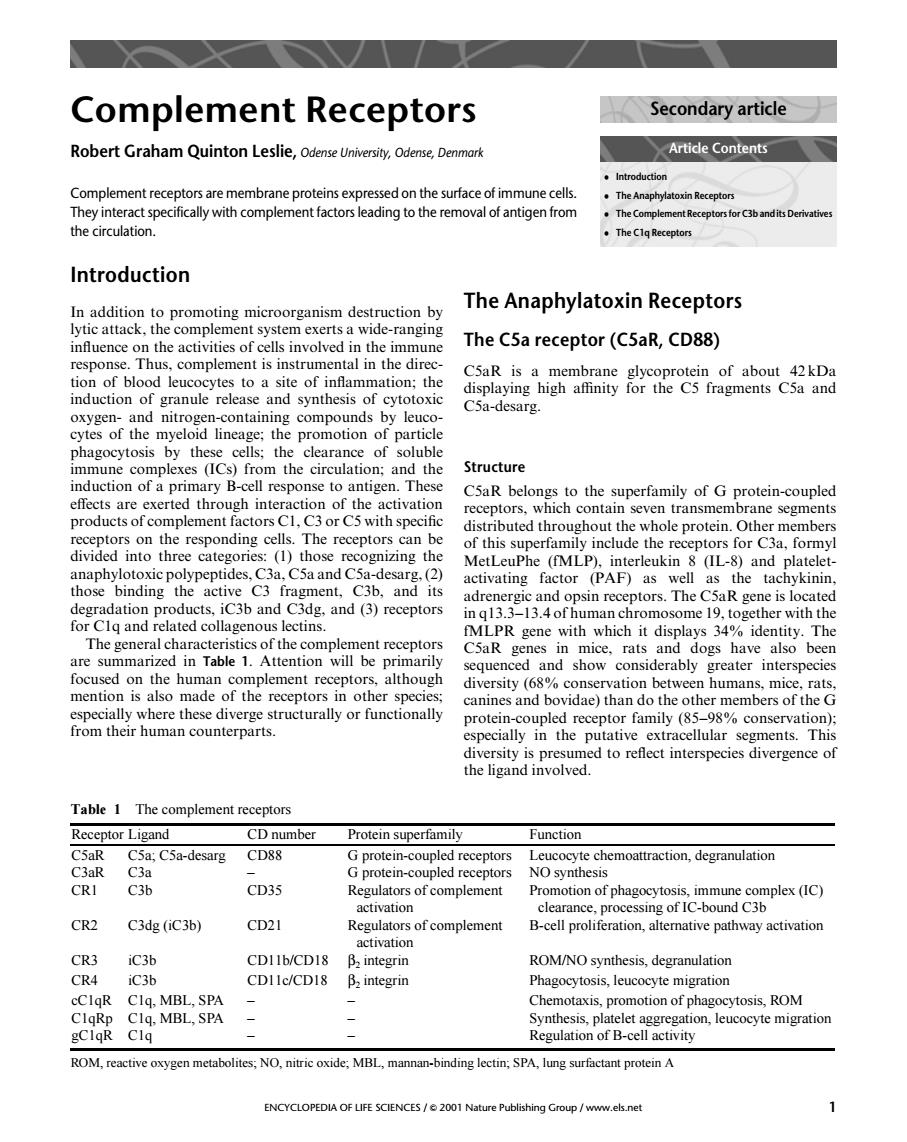正在加载图片...

Complement Receptors Secondary article Robert Graham Quinton Leslie,Odense University.odense,Denman Artice Contents duction Complement receptors are membrane proteins expressed on the surface of immune cells. They interact specifically with complement factors leading to the removal of antigen from 。The Con ent Receptors for C3b and its Derivative the circulation. ·The Clq Receptors Introduction In addition to promoting microorganism destruction by The Anaphylatoxin Receptors The C5a receptor(C5aR,CD88) tion of blood leucocvtes to a site of inflammation:the induction of granule release and synthesis of cytotoxic immune complexes (ICs)from the circulation:and the Structure induction of a primary B-cell response to antigen.These to the ctivation pro distributed throughout the whole protein.Other members y include the ceptors for C3a,formyl .(2 and pla oinding the fragment and dre nd o and (3)receptors tors.The C5aR gene is located n q13.3-13.4of human chromosome 19.together with the s lectin The general characteristics of the complement receptors are summarized in Table 1.Attention will be primarily and smice focused on the hur diversity (68%conservation between humans,mice,rats canines and bovidae)than do the other members of the c from their human counterparts. spec the int ergen Table 1 The complement receptors Receptor Ligand CD number Protein superfamily Function CsaR C5a;CSa-desarg CD88 G protein-coupled receptors eucocyte chemoattraction,degranulation n-c C3b pled receptor NO习ynthes CD35 sof complemen on of phago CR2 C3dg (iC3b) CD21 Regulators of complement B-cell proliferation,altemative pathway activation activation iC3b CDIIb/CD18 B,integrin ROM/NO synthesis,degranulation CR4 iC3b CDIIc/CD18 B,integrin Phagocytosis,leucocyte migration C1q.MBL,SPA Chemotaxis,promotion of phagocytosis,ROM Syntnesis,plat let aggregation,leucocyte migration Regulation of B-ce ROM,reactive xygen MBL mannan-bindingectin SPA,ung sfactant proteinA ENCYCLOPEDIA OF LIFE SCIENCES/2001 Nature Publishing Group/www.els.net Complement Receptors Robert Graham Quinton Leslie, Odense University, Odense, Denmark Complement receptors are membrane proteins expressed on the surface of immune cells. They interact specifically with complement factors leading to the removal of antigen from the circulation. Introduction In addition to promoting microorganism destruction by lytic attack, the complement system exerts a wide-ranging influence on the activities of cells involved in the immune response. Thus, complement is instrumental in the direction of blood leucocytes to a site of inflammation; the induction of granule release and synthesis of cytotoxic oxygen- and nitrogen-containing compounds by leucocytes of the myeloid lineage; the promotion of particle phagocytosis by these cells; the clearance of soluble immune complexes (ICs) from the circulation; and the induction of a primary B-cell response to antigen. These effects are exerted through interaction of the activation products of complement factors C1, C3 or C5 with specific receptors on the responding cells. The receptors can be divided into three categories: (1) those recognizing the anaphylotoxic polypeptides, C3a, C5a and C5a-desarg, (2) those binding the active C3 fragment, C3b, and its degradation products, iC3b and C3dg, and (3) receptors for C1q and related collagenous lectins. The general characteristics of the complement receptors are summarized in Table 1. Attention will be primarily focused on the human complement receptors, although mention is also made of the receptors in other species; especially where these diverge structurally or functionally from their human counterparts. The Anaphylatoxin Receptors The C5a receptor (C5aR, CD88) C5aR is a membrane glycoprotein of about 42 kDa displaying high affinity for the C5 fragments C5a and C5a-desarg. Structure C5aR belongs to the superfamily of G protein-coupled receptors, which contain seven transmembrane segments distributed throughout the whole protein. Other members of this superfamily include the receptors for C3a, formyl MetLeuPhe (fMLP), interleukin 8 (IL-8) and plateletactivating factor (PAF) as well as the tachykinin, adrenergic and opsin receptors. The C5aR gene is located in q13.3–13.4 of human chromosome 19, together with the fMLPR gene with which it displays 34% identity. The C5aR genes in mice, rats and dogs have also been sequenced and show considerably greater interspecies diversity (68% conservation between humans, mice, rats, canines and bovidae) than do the other members of the G protein-coupled receptor family (85–98% conservation); especially in the putative extracellular segments. This diversity is presumed to reflect interspecies divergence of the ligand involved. Article Contents Secondary article . Introduction . The Anaphylatoxin Receptors . The Complement Receptors for C3b and its Derivatives . The C1q Receptors Table 1 The complement receptors ROM, reactive oxygen metabolites; NO, nitric oxide; MBL, mannan-binding lectin; SPA, lung surfactant protein A Receptor Ligand CD number Protein superfamily Function C5aR C5a; C5a-desarg CD88 G protein-coupled receptors Leucocyte chemoattraction, degranulation C3aR C3a – G protein-coupled receptors NO synthesis CR1 C3b CD35 Regulators of complement activation Promotion of phagocytosis, immune complex (IC) clearance, processing of IC-bound C3b CR2 C3dg (iC3b) CD21 Regulators of complement activation B-cell proliferation, alternative pathway activation CR3 iC3b CD11b/CD18 β2 integrin ROM/NO synthesis, degranulation CR4 iC3b CD11c/CD18 β2 integrin Phagocytosis, leucocyte migration cC1qR C1q, MBL, SPA – – Chemotaxis, promotion of phagocytosis, ROM C1qRp C1q, MBL, SPA – – Synthesis, platelet aggregation, leucocyte migration gC1qR C1q – – Regulation of B-cell activity ENCYCLOPEDIA OF LIFE SCIENCES / & 2001 Nature Publishing Group / www.els.net 1